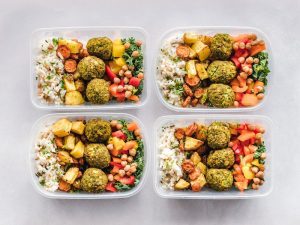How to Make Delicious Gluten-Free Meals
How to Make Delicious Gluten-Free Meals


Introduction
Gluten-free eating has gained popularity in recent years, whether due to dietary restrictions or personal choice. However, following a gluten-free diet doesn’t mean sacrificing taste or variety. With the right ingredients and techniques, you can create delicious gluten-free meals that everyone can enjoy. In this article, we will explore tips and techniques to help you make mouthwatering gluten-free meals that will satisfy your taste buds.
Understanding Gluten and Gluten-Free Ingredients
Gluten is a protein found in wheat, barley, and rye. People with celiac disease, gluten intolerance, or gluten sensitivity need to avoid gluten-containing ingredients. When cooking gluten-free meals, it’s essential to use alternative ingredients that are naturally gluten-free or specifically labeled as gluten-free. Some common gluten-free ingredients include:
Grains: Rice, quinoa, corn, millet, amaranth, and sorghum.
Flours: Almond flour, coconut flour, rice flour, and gluten-free flour blends.
Starches: Potato starch, tapioca starch, and arrowroot starch.
Binders: Xanthan gum and guar gum (used to mimic the elasticity of gluten).
1. Choose Naturally Gluten-Free Foods
Many whole foods are naturally gluten-free, making them a great foundation for delicious meals. Include plenty of fruits, vegetables, lean proteins, dairy products (if tolerated), legumes, and nuts in your gluten-free recipes. These ingredients provide a variety of flavors, textures, and nutrients, ensuring your meals are both satisfying and nutritious.
2. Experiment with Gluten-Free Flours
When it comes to baking or breading, using gluten-free flours is essential. Experiment with different gluten-free flour options like almond flour, coconut flour, or gluten-free flour blends. Each type of flour has a unique flavor and texture, so it’s worth trying different combinations to find what works best for your desired outcome. You can also find gluten-free baking mixes that simplify the process.
3. Get Creative with Spices and Seasonings
To enhance the flavor of your gluten-free meals, get creative with spices and seasonings. Use a variety of herbs, spices, and condiments to add depth and complexity to your dishes. Experiment with different combinations to find your favorite flavor profiles. Don’t be afraid to try international spices and seasonings to add a global flair to your gluten-free cuisine.
4. Explore Gluten-Free Alternatives
Don’t let the absence of gluten limit your culinary adventures. Explore gluten-free alternatives for your favorite dishes. For example, use gluten-free pasta made from rice or corn instead of traditional wheat-based pasta. Explore gluten-free bread options or make your own using gluten-free flours. There are also gluten-free versions of popular snacks and desserts available in stores or online.
5. Pay Attention to Cross-Contamination
When cooking gluten-free meals, it’s crucial to avoid cross-contamination with gluten-containing ingredients. Clean your kitchen surfaces, utensils, and cookware thoroughly before preparing gluten-free meals. Use separate cutting boards, toasters, and cooking utensils to prevent cross-contamination. Be mindful of shared condiments or ingredients that may contain hidden sources of gluten.
6. Embrace Naturally Gluten-Free Recipes
Rather than trying to modify every recipe to be gluten-free, embrace naturally gluten-free recipes. There are numerous dishes that are naturally gluten-free, such as salads, stir-fries, roasted vegetables, grilled meats, and fruit-based desserts. These recipes require minimal adjustments and can be just as delicious as their gluten-containing counterparts.
7. Explore Gluten-Free Cookbooks and Online Resources
Expand your repertoire of gluten-free recipes by exploring gluten-free cookbooks and online resources. There are countless websites, blogs, and social media accounts dedicated to gluten-free cooking, offering a wealth of recipe ideas and inspiration. Join online communities or forums to connect with other gluten-free cooks, exchange recipes, and learn from their experiences.
8. Practice Label Reading
When shopping for ingredients, it’s important to read labels carefully. Look for products that are specifically labeled as gluten-free to ensure they meet your dietary needs. Be cautious of hidden sources of gluten, such as soy sauce, marinades, or packaged seasonings that may contain wheat-based ingredients. Familiarize yourself with common gluten-containing ingredients and their alternative names.
9. Plan Ahead and Meal Prep
Planning ahead and meal prepping can make gluten-free cooking easier and more convenient. Set aside time to plan your meals for the week, create a shopping list, and prepare some components in advance. Cook larger batches of gluten-free staples like rice, quinoa, or roasted vegetables that can be used in multiple meals throughout the week. Having prepared ingredients on hand will save time and effort when it comes to meal preparation.
10. Share and Educate Others
Share your gluten-free meals with friends and family to show them that gluten-free cooking can be delicious and enjoyable. Educate others about gluten-free ingredients, cross-contamination risks, and the importance of accommodating dietary needs. By spreading awareness, you contribute to a more inclusive and understanding culinary community.
Conclusion
Making delicious gluten-free meals is all about using the right ingredients, exploring creative flavors, and being mindful of cross-contamination risks. By choosing naturally gluten-free foods, experimenting with gluten-free flours, getting creative with spices and seasonings, exploring gluten-free alternatives, paying attention to cross-contamination, embracing naturally gluten-free recipes, utilizing cookbooks and online resources, practicing label reading, planning ahead and meal prepping, and sharing your creations, you can enjoy a wide variety of mouthwatering gluten-free meals. With a little creativity and culinary know-how, gluten-free cooking can be a flavorful and satisfying culinary adventure.
Tips for Making Delicious Gluten-Free Meals:
1. Choose naturally gluten-free foods as the foundation for your meals.
2. Experiment with different gluten-free flours for baking and breading.
3. Use a variety of spices and seasonings to enhance the flavor of your dishes.
4. Explore gluten-free alternatives for your favorite recipes.
5. Be mindful of cross-contamination and keep your kitchen gluten-free.
6. Embrace naturally gluten-free recipes to simplify the cooking process.
7. Seek inspiration from gluten-free cookbooks and online resources.
8. Read labels carefully and choose gluten-free products.
9. Plan ahead and meal prep to make gluten-free cooking more convenient.
10. Share your gluten-free meals and educate others about gluten-free cooking.





